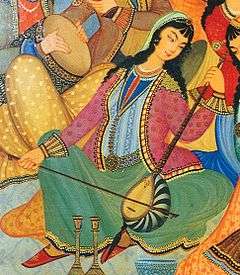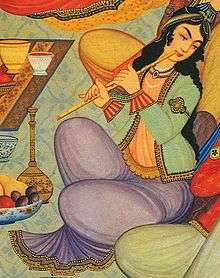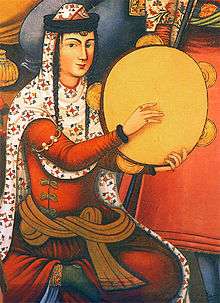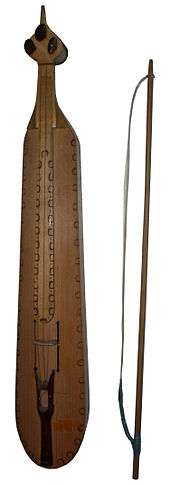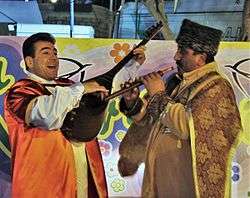Oud
The oud (/uːd/) is a pear-shaped stringed instrument with 11 or 13 strings grouped in 5 or 6 courses, commonly used in Persian, Arabic, Greek, Turkish, Jewish, Byzantine, Azerbaijani, Armenian, North African (Chaabi, Classical, and Spanish Andalusian), Somali and Middle Eastern music.
Construction of the oud is similar to that of the lute.[1] The modern oud and the European lute both descend from a common ancestor via diverging paths. One instrument that has been suggested as ancestral is the barbat.[2] The oud is readily distinguished from the lute by its lack of frets and smaller neck. Alongside the lute, it is considered an ancestor of the guitar.[3] The oldest surviving oud is thought to be in Brussels, at the Museum of Musical Instruments.[4]
Names and etymology
The origin of the name oud (and its etymological cousin, lute) for the musical instrument is North African but its maker is unknown. The Arabic: العود (al-ʿūd) literally denotes a thin piece of wood similar to the shape of a straw. It may refer to the wooden plectrum traditionally used for playing the oud, to the thin strips of wood used for the back, or to the wooden soundboard that distinguished it from similar instruments with skin-faced bodies.[5]
Research by Eckhard Neubauer suggests that oud may simply be an Arabic borrowing from the Persian word rōd or rūd, which meant string, stringed instrument, or lute.[6][7] Eckhart had been cited in articles in the Encyclopædia Iranica.[8]
Another researcher, archaeomusicologist Richard J. Dumbrill, suggests that rud came from the Sanskrit rudrī (stringed instrument) and transferred to Arabic through a Semitic language.[9]
Names for the instrument in different languages include Arabic: عود ʿūd (Arabic pronunciation: [ʕu(ː)d, ʢuːd], plural: أعواد aʿwād), Armenian: ուդ, Syriac: ܥܘܕ ūd, Greek: ούτι oúti, Hebrew: עוּד ud, Persian: بربط barbat, Kurdish: ûd, Turkish: ud or ut,[10] Azeri: ud, and Somali: cuud or kaban.
History
The oud was created during the early pharaonic era, and according to Farabi, the oud was invented by Lamech, the sixth grandson of Adam. However, there is no historical corroboration of this assertion.
The oldest pictorial record of a lute dates back over 5000 years, on a cylinder seal from the Uruk period in northern Syria, Mesopotamia. Acquired by Dr. Dominique Collon, the artifact is currently housed at the British Museum.[11]
The Turkic peoples had a similar instrument called the kopuz. This instrument was thought to have magical powers and was brought to wars and used in military bands. This is noted in the Göktürk monument inscriptions. The military band was later used by other Turkic state's armies and later by Europeans.[12]
The oud has a particularly long tradition in Iraq,[13] where a saying goes that in its music lies the country’s soul.[13] A ninth-century Baghdad jurist praised the healing powers of the instrument, and the 19th-century writer Muhammad Shihab al-Din related that it "places the temperament in equilibrium" and "calms and revives hearts."[13] Following the invasion of Iraq and the overthrow of the Ba'athist regime in 2003, however, the increasing fervor of Islamic militants who consider secular music to be haraam (sinful) forced many oud players and teachers into hiding or exile.[13]
Types
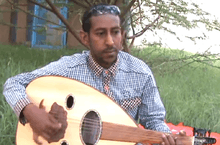
Modern-day ouds fall into two categories: Arabic and Turkish. This distinction is not based solely on geography since Turkish ouds can also be found in Greece and occasionally other parts of the Mediterranean, whereas Arabic ouds can be found in various locations all over the Arab world. The Arabic ouds, such as the Iraqi oud, Egyptian oud and Syrian oud, are normally grouped under the term 'Arabic oud' because of their similarities.[14] However, all these categories are very recent, and do not do justice to the variety of ouds made in the 19th century, and also today.[15]
Arabic ouds are normally larger than their Turkish counterpart, producing a fuller, deeper sound, whereas the sound of the Turkish oud is more taut and shrill, not least because the Turkish oud is tuned one whole step higher than the Arabic. Turkish ouds tend to be more lightly constructed than Arabic with an unfinished sound board, lower string action and with string courses placed closer together. Arabic ouds have a scale length of between 61 cm and 62 cm in comparison to the 58.5 cm scale length for Turkish.[16]
The Cümbüş is a Turkish instrument that started as a hybrid of the oud and the banjo.
See also
- Turkish music
- Arabic music
- Zaidoon Treeko
- Byzantine music
- Hebrew music
- Somali music
- Armenian music
- Middle Eastern and North African music traditions
- List of oud makers
- List of oud players
- Arabic Oud House
References
- ↑ Mottola, R.M. (Summer–Fall 2008). "Constructing the Middle Eastern Oud with Peter Kyvelos". American Lutherie (94, 95).
- ↑ "Encyclopaedia Iranica - Barbat". Iranicaonline.org. 1988-12-15. Retrieved 2012-02-04.
- ↑ Summerfield, Maurice J. (2003). The Classical Guitar, Its Evolution, Players and Personalities Since 1800 (5th ed.) Blaydon on Tyne: Ashley Mark Publishing. ISBN 1-872639-46-1
- ↑ "Alexandria to Brussels, 1839". oudmigrations. Retrieved 2016-04-15.
- ↑ During, Jean. "'Barbat'". Encyclopedia Iranica. Retrieved 17 April 2011.
- ↑ Douglas Alton Smith. A History of the Lute from Antiquity to the Renaissance. p. 9. Lute Society of America (LSA), 2002. ISBN 0-9714071-0-X.
- ↑ "Asian Music Tribal Music of India, 32, 1, Fall, 2000/ Winter, 2001". Utexas.edu. Retrieved 2010-12-23.
- ↑ Encyclopedia Iranica, MUSIC HISTORY ii. CA. 650 TO 1370 CE
- ↑ Dumbrill, Richard J. (1998). The Archaeomusicology of the Ancient Near East. London: Tadema Press. p. 319.
- ↑ Güncel Türkçe Sözlük'te Söz Arama (Turkish)
- ↑ Mitra Jahandideh; Shahab Khaefi; Ahanali Jahandideh; Masoud Khaefi, Using the Root Proportion to Design an Oud (PDF), Department of Music, Faculty of Fine Art, Tehran University, Tehran, IRAN
- ↑ Fuad Köprülü, Türk Edebiyatında İlk Mutasavvıflar (First Sufis in Turkish Literature), Ankara University Press, Ankara 1966, pp. 207, 209.; Gazimihal; Mahmud Ragıb, Ülkelerde Kopuz ve Tezeneli Sazlarımız, Ankara University Press, Ankara 1975, p. 64.; Musiki Sözlüğü (Dictionary of Music), M.E.B. İstanbul 1961, pp. 138, 259, 260.; Curt Sachs, The History of Musical Instruments, New York 1940, p. 252.
- 1 2 3 4 Erica Goode (May 1, 2008). "A Fabled Instrument, Suppressed in Iraq, Thrives in Exile". New York Times.
- ↑ What is the difference between Arabic and Turkish ouds?
- ↑ "The journeys of Ottoman ouds". oudmigrations. 2016-03-08. Retrieved 2016-04-26.
- ↑ Types of oud
Further reading
- Rebuffa, David. Il Liuto, L'Epos, (Palermo, 2012), pp. 22–34.
External links
| Wikimedia Commons has media related to Ouds. |


